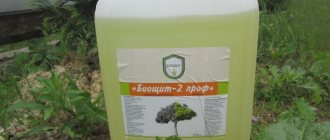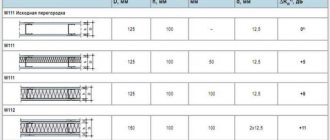Modern summer residents do not want to put up with the everyday inconveniences of country life and equip their homes with autonomous engineering systems. Thus, to organize wastewater treatment, many purchase special devices - septic tanks. One of the most popular models of such installations is the “Tank” septic tank. This model is available in several modifications with different performance. Let's look at the advantages and disadvantages of the Tank septic tank, and what problems may arise during its operation.
Thanks to the wide range of treatment plants produced by modern manufacturers, installing a sewer system in a country house or country house has ceased to be a problem.
Anyone can choose an installation that suits them in terms of performance, characteristics and cost. When choosing a septic tank model, you should pay attention to its technical characteristics, but also to the reviews left by people who already have experience in operating this installation.
Description and principle of operation
The “Tank” line of septic tanks includes both anaerobic (non-volatile) and aerobic (depending on the availability of electricity) designs. There is a modification for any home with 1 to 10 people living in it. This treatment facility is manufactured at the factory from plastic. The body is made in the form of a straight parallelepiped with one or more necks on top.
Exterior view of the Tank-2 septic tank
The processing of sewage waste inside the Tank septic tank proceeds as follows:
- Effluent from the house first enters the first chamber, where heavy fractions settle.
- Then these clarified waters flow by gravity into the second chamber, where the organic matter in them is processed by microorganisms.
- The third settling chamber is a compartment with a biofilter designed to cut off small inclusions remaining in the wastewater and send them back for post-treatment.
Diagram of the operating principle of a septic tank Tank
The sewage water leaving this septic tank has a purification degree of 75–80%. Next, they are sent to a well with drainage or an infiltrator, where moisture is drained into the soil.
What is inside?
The Tank treatment plant consists of several plastic containers, inside of which there are partitions that separate the total volume into several autonomous chambers. These are settling tanks and a biofilter. The volume can be increased almost indefinitely by connecting additional cameras.
The design is very simple to design and operate, reliable and durable, since a modular assembly system is used and polypropylene is used in the manufacture of the treatment plant. The walls are very thick and, despite this, elastic, so the septic tank can easily withstand soil pressure and seasonal movements.
This wastewater treatment option will be optimal for people who want to get quality for relatively little money.
For an additional fee, the Septic Tank is equipped with infiltrators, which provide additional treatment of dirty wastewater before discharging it into the soil. It is relatively small in size, so if desired, you can install it yourself, that is, you don’t have to call an excavator to dig a pit, but dig a hole yourself.
This same advantage allows you to install a septic tank anywhere on the site - only ventilation pipes and an inspection hatch will be visible from the ground.
Once or twice a year, depending on the volume, you will need to call a vacuum cleaner to pump out residues that contain solid particles and cannot be absorbed into the soil.
The septic tank is available in four modifications, which differ in the volume of the main tank.
For example, “Tank 2” is designed for a family of 4 people, and the treatment plant “Tank 1” can withstand the load of a family of maximum 3 people. Although any of these models can always be supplemented with auxiliary containers to increase volume.
Septic tank and its modifications
The manufacturer offers customers the Tank septic tank in five versions:
- Tank-1 – volume 1200 liters for 1–3 people.
- Tank-2 - volume 2000 liters for 3-4 people.
- Tank-2.5 – volume 2500 liters for 4–5 people.
- Tank-3 - volume 3000 liters for 5-6 people.
- Tank-4 – volume 3600 liters for 7–9 people.
Model range of septic tanks Tank
Depending on the model, the productivity of the septic tank ranges from 600 to 1800 liters/day. All of these stations are anaerobic and do not require power.
In addition to the main model, the developer of septic tanks under the Tank brand offers three more modifications:
- "TankUniversal" - with a reinforced hull;
Septic tank Tank-Universal - “MicrobeMini” is a compact option for cottages and houses designed for seasonal living;
Septic tank MicrobeAt the dacha, it is best to install a model from the MicrobMini series. This is a cheap and quite productive solution for a summer cottage. Such a station can even be included in the design of a small house. But only if it will be used for seasonal living. If you live outside the city permanently, you need a more powerful and capacious bio-treatment station.
- “BioTank” – with aerobic bacteria, does not require a filtration field.
Unlike all other variations, the BioTank septic tank belongs to the aerobic category of VOCs. It has a compressor for pumping oxygen to aerate the waters. Without pumping air, the efficiency of organic-eating bacteria in it will be too low. At the same time, for high productivity and increased quality of cleaning (here it reaches 95%) you have to pay with electricity. This modification is volatile.
Septic tank BiotankAll Tank septic tanks with the “Bio” prefix are divided into two series “SAM” and “PR”. In the first case, the movement of wastewater between the chambers and the removal of treated water from the station occurs by gravity. But the second option has a pump in its design for the forced release of purified water.
Models of septic tanks Tank
| Septic tank | Human | LxWxH | Volume | Produces. | Price from* |
| Tank-1 | 1-3 | 1200x1000x1700 mm | 1200 l | 600 l/day | 17000 rub. |
| Tank-2 | 3-4 | 1800x1200x1700 mm | 2000 l | 800 l/day | 26000 rub. |
| Tank-2.5 | 4-5 | 2030x1200x1850 mm | 2500 l | 1000 l/day | RUB 32,000 |
| Tank-3 | 5-6 | 2200x1200x2000 mm | 3000 l | 1200 l/day | RUB 38,000 |
| Tank-4 | 7-9 | 3800x1000x1700 mm | 3600 l | 1800 l/day | RUB 69,000 |
*Prices are indicative for 2022 excluding installation
Specifications
The main technical characteristics of Tank-1 septic tanks are presented in the table.
| Index | Indicator value |
| Number of users, people | 42767 |
| Length, mm | 1200 |
| Width, mm | 1000 |
| Height, mm | 1700 |
| Volume, l | 1200 |
| Productivity, m3/day | 0.6 |
| Weight, kg | 85 |
| Cost, rub. | up to 30000 |
Of all the technical indicators, the first thing you should pay attention to is the total weight of the installation. Today, the device is one of the lightest among similar treatment plants from other manufacturers.
Also, one cannot ignore the low cost, amounting to an amount approximately equal to that spent on arranging a cesspool.
In addition, it is possible to retrofit the septic tank with additional equipment:
- extensions on the neck, allowing the structure to be deepened to the required level;
- fecal pump;
- capacity for storing treated waste.
Pros and cons of septic tank Tank
Among the many positive aspects of the Tank septic tank and all its modifications, the following are worth mentioning:
- Affordability (in terms of total costs, the station is even cheaper than its analogue made from concrete rings);
- Energy independence (except for BioTank);
- Possibility of installation on soils of any type and water content;
- Small size and lightweight design, facilitating manual installation;
- High strength plastic housing;
- Extreme ease of operation and maintenance;
- Low probability of clogging of internal chambers;
- Service life up to half a century.
The septic tanks in question can be installed on the site at any time of the year. Problems will arise only with digging frozen ground. You can choose a place for the “Tank” right next to the house at a distance of 2–3 meters from it. It doesn’t matter whether a strip or column foundation is used to build housing, moisture from the sealed housing will not seep into the ground and affect the concrete.
But the infiltrator should be removed from the base of the building, on the contrary, further away. The humidity around it is always high. If you place it next to a residential building, then even precipitation-resistant facade plaster from the walls of the house will sooner or later begin to fall off.
The negative aspects of this septic tank are as follows:
- Large volumes of work when digging a pit for the station and installing an infiltrator;
- The need to organize additional treatment using a filtration field or well.
The effluent in the anaerobic VOC "Tank" is treated only up to 80%. Without the use of an infiltrator, such water cannot be discharged into a reservoir or used for watering beds. In this regard, this septic tank is somewhat inferior to competitors of the same factory design.
Septic tank installation diagrams
For highly absorbent soils, a standard installation scheme is used. In this case, a hole is dug 50–60 cm deep than the height of the main body. The width and length of this pit should also exceed the dimensions of the station by 60 cm.
Next, a sand cushion 10 cm thick is formed at the bottom and a treatment structure is installed on top of it. There is no need to pour an “anchor” under it or lay concrete or aerated concrete blocks. After installation in place, the top and sides of the septic tank are filled with a sand-cement mixture. In northern regions, additional insulation is laid on top. Afterwards everything is sprinkled with a 30–35 cm layer of earth.
Septic tank installation diagram Tank for absorbent soils
A filtration field on absorbent soil is formed behind the septic tank at a distance of 2–40 meters from it. They are connected to each other by a straight pipe at a slope of 1–2 degrees. The drainage filter under the infiltrator is made of a 40-centimeter layer of crushed stone. In addition to the latter, you can take brick, broken tiles or other moisture-resistant building materials.
If the soil on the site is clayey or the groundwater level is high, then the “Tank” will have to be installed according to a scheme with a filter trench and a storage well. In this case, purified water will gradually accumulate in a special tank, and then be pumped to the ground or for removal by a sewer barrel.
Septic tank installation diagram Tank for non-absorbent and poorly absorbent soils
With this installation, the outlet from the septic tank does not go into the plastic infiltrator, but directly into the filter layer of crushed stone. Below this filter there is another one with a receiving pipe connected to the storage tank.
General diagram of the operating principle
How to increase system efficiency?
Microorganisms are distributed throughout the entire volume of the septic tank and are concentrated in the bioload. They enter the system along with wastewater, and, if there is a sufficient amount of organic matter, they successfully grow, multiply and eat organic components.
Thanks to bacteria, constant fermentation occurs in the septic tank. Due to this, organic matter, mineral suspensions and fat fractions are separated - the liquid is stratified.
The efficiency of wastewater treatment depends on the size of the microorganism population. The market offers a large selection of ready-made preparations containing colonies of bacteria - bioactivators. A popular drug is Doctor Robik.
By periodically adding them to the system, home owners improve the quality of cleaning. This is also an effective prevention against problems that arise when the bacterial population decreases - unpleasant odor, the formation of thick deposits on the walls, hardening of sludge.
The activity of anaerobes contributes to the liquefaction of bottom silt and dense crust on the surface, due to which the sewer service can be called much less frequently - once every three years.
The choice of drugs containing bacteria on the market is huge. When choosing, it is necessary to take into account the living conditions of microorganisms. Aerobes that require constant access to oxygen are not suitable for Tank septic tanks - their use can cause an imbalance in the operation of the system
When is the use of a bioactivator necessary?
For the normal functioning of bacteria, it is necessary that organic matter and a sufficient amount of liquid enter the system. Accordingly, for a constantly functioning septic tank, the use of industrial biological preparations is not necessary.
However, violations in operation lead to the death of colonies, as evidenced by the appearance of an unpleasant odor. In this case, the bioactivator should be added first. Most often, such a measure is sufficient to restore normal operation of the cleaning system.
In the following cases, you should not wait for the smell to appear, since in any case they help reduce the population of microorganisms.
It is better to immediately add a ready-made biological product, which is administered:
- After a long period of inactivity - for example, at the beginning of the summer season. If conservation was carried out properly, the bacteria in the septic tank do not die. However, their number is significantly reduced. The bioactivator helps to establish the functioning of the system in a much shorter time than would occur under natural conditions.
- and disinfectants into the sewer
- After the liquid freezes in the septic tank . This can happen if the tank is installed without an insulating layer.
Sewage odors also occur when a thick layer of fatty deposits has accumulated on the drain pipes and walls. Artificially added colonies of bacteria break down and liquefy sediments, after which they freely flow into the sump.
How to apply a bioactivator?
A couple of buckets (about 20 liters) of water are poured into the sewer. In order for the biomaterial to get into the septic tank, it is poured or poured into the toilet. After this, the water is drained two or three times.
Before introducing a bacterial preparation into the sewer, you should read the manufacturer's instructions
Before use, liquid preparations are simply shaken, but products in tablets or granules should be applied in accordance with the attached instructions. Some manufacturers recommend dissolving the biomaterial in water, others recommend adding it dry.
After adding the bacterial preparation, monitor the water level in the septic tank for two to three days, adding it as needed.
Why is additional filtration needed?
Anaerobes are not able to completely process organic compounds. They decompose complex compounds into simpler ones, which are contained in the liquid leaving the septic tank.
By pouring such water into the ground, you can become the culprit of contamination of it and groundwater. To completely break down simple organic matter, plums are exposed to aerobic bacteria.
When installing natural additional filtration, water from the septic tank passes through a layer of crushed stone or gravel, which is well saturated with oxygen. Aerobic microorganisms settle in such a filtration layer, the colonies of which grow and multiply when nutrient organic matter enters.
In this way, the last stage of complete wastewater treatment in the sewer system is carried out based on the Tank septic tank.
Reviews of septic tanks Tank
Reviews for the septic tank in question are full of laudatory epithets. Those who bought the “Tank” write that it is cheap, can be installed in literally 3-4 hours, has a durable body and, due to its modular design, allows you to quickly increase the station’s capacity at any time.
At the same time, the main complaint that owners have about it is the need for frequent cleaning. But this happens more due to incorrectly selected volume. Sludge accumulates in the septic tank and must be removed from time to time. To do this less often, you just need to choose a VOC with a larger capacity.
Positive reviews
- I installed a Tank-1 septic tank sewage system on a country house. In my opinion, this is the most optimal solution for me. Ease of operation, reliable design, and a good company that has been involved in wastewater treatment plants for 8 years. © Tractor driver, forum.rmnt.ru
- We encountered the same problem. A lot of information was shoveled through. It seems that we settled on the “TANK” septic tank. The spouse considers him the most accessible and correct. © Sofia166, forum.rmnt.ru
Negative reviews
- Septic tanks such as TANK, TVER, etc. disappeared immediately, because these are septic tanks that do not purify water as efficiently, without an aeration system, but I wanted maximum purification, and these are only biological treatment stations such as TOPAERO, TOPAS and POPLER, which I did not know at the time of purchasing TOPAS. © panamera, forum.rmnt.ru
- I don’t like experiments, it can be too expensive, I only choose proven products when they work well. I also know the Tank, it’s popular, my neighbor installed it, he told me something about it, the plastic is fragile, it bends... © Vladimir 123, forum.rmnt.ru
- There are enough problems with him. Google it and you'll find everything. Well, and the price... why do all this when a normal three-cubic plastic barrel costs around thirty? Attaching pipes and a neck to it is not so difficult, but you don’t have to overpay and immediately redo it. © Serega1998, forum.vashdom.ru
- Is it true that a septic tank cannot cope with the drainage of the dishwasher and washing machine? I was about to buy it, and then they told me such negative things. So there are living organisms there. They will use yours with pleasure, but washing powder - sorry. You will poison them with detergents. © qwerqus, forum.vashdom.ru
- Well, the work is finished, I spent the whole summer on weekends. But in the end I thought, the next season will begin, and I will begin to enjoy the fruits of my labor. Aaaand... Arriving at the dacha in the spring, the first thing I did was run to see what was wrong with the septic tank, what was my surprise when I saw the lids slightly floating above the necks. The septic tank was full of clean water. At first I thought that it was flooded with melted snow from the top through the covers, since they were a little below ground level, I remembered the kind words of the Triton plastic managers, who deceived me with the input, which is why I had to shackle it so deeply, and began to pump it out water from the last well. After exposing the outlet pipe, I saw that water was pouring out of the septic tank in almost the same volume as it was being pumped out: mad: half an hour after turning off the pump, the septic tank was full. Having put on my fishing overalls, I climbed inside to inspect the connections.
This is not the biggest leak yet. From the connection of the first and second there are two such jets and with high pressure. ALL connections where black plastic is used (nipples from tanks) are leaking, even the last day off. Only the ill-fated inlet into the septic tank does not leak because it is made of a purchased plastic sewer corner and is embedded through a rubber coupling. Moreover, the connections bought in the store have retained their original roundness, and it flows precisely because the black nipples of the tanks seem to have been flattened and narrowed.
Morality, a lost summer, a lot of hassle and money, and a non-working septic tank that now needs to be dug up again and have sex with it. © Calisto, forumhouse.ru
- Well, I won’t say anything about bourgeois septic tanks, but I bought a TANK along with infiltrators last year. The quality is of course disgusting, the infiltrators ended up with a “bottom” due to sagging plastic underneath, and it took me a long time to cut off these swells with a knife. The inlet and outlet pipes in the septic tank were gray, that is, for internal work, I changed them to orange (someone in Triton “saved”). The circuit with a check valve only works on paper, my valve is always half-open in the well, thank God I didn’t buy the valve in Triton, but somewhere else, it has a lever to close it.
In Triton, one very “smart” manager, when purchasing, advised, if the groundwater level is high, to install a filtration well on rings without a bottom...
In general, the TANK has one plus so far - the price; the bourgeois ones are still VERY expensive. © jarosl, forumhouse.ru
- This is a manufacturing defect, after buying Tank-2, my water also began to leak, I contacted the “RESPECTED” office of the manufacturer of these miracle septic tanks, for a week I could not get an answer, in the end I called their “ENGINEER” and said poop more and the hole in the septic tank will silt up! Demand a replacement. © ilya811, forumhouse.ru
- I also encountered the same problem. All winter everything was fine, but today I went to see what was there and how it was - I discovered that the water from the septic tank had gone to the level of the overflow pipe from the containers. It is not yet clear where exactly the water goes. There is a suspicion of a vertical crack in the rib in the second tank. Located at approximately the same level. The height is 20-30 centimeters. The width is not large - as if a line was drawn with a simple pencil (maybe it’s not a crack at all, but a problem in another place). There are no options to call someone, dig them up, etc. - all this is not realistic. You can only pump out the septic tank and get in to specifically examine everything, and, if possible, brew it. By the way, I don’t know what you see as the problem with sealing - doesn’t the septic tank material melt? Take an industrial hair dryer and treat the crack... © Iserlohner, forumhouse.ru











